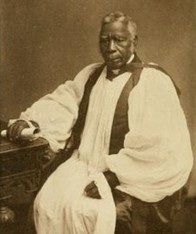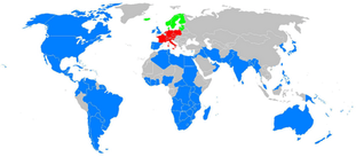Church Connections: The Anglican Communion
 The Compass Rose is the symbol of the Communion
The Compass Rose is the symbol of the Communion
The Anglican Communion is a loosely connected group of national churches with shared historical roots in the Book of Common Prayer tradition of the Church of England. Anglicanism is the third-largest Christian communion, following only the Roman Catholic Church and the Eastern Orthodox churches in size. Anglicans can be found all over the world, but are especially prevalent in sub-Saharan Africa.
Anglicans are orthodox Christians who believe in Jesus Christ. Anglicans believe that the Bible is the Word of God, and fully accept the teachings of the first five Ecumenical Councils of the church, including the doctrine of the Trinity and the Chalcedonian definition describing Christ as both fully man and fully God.
The national churches are organized into provinces and are united by four instruments of unity: the Anglican Consultative Council (a body of clergy and lay people selected from the provinces), the Primates Meetings (a meeting of the head bishops of each church), the Lambeth Conference (a decennial meeting of all the bishops throughout the Communion), and the Archbishop of Canterbury (the spiritual head of the church).
Anglicans are orthodox Christians who believe in Jesus Christ. Anglicans believe that the Bible is the Word of God, and fully accept the teachings of the first five Ecumenical Councils of the church, including the doctrine of the Trinity and the Chalcedonian definition describing Christ as both fully man and fully God.
The national churches are organized into provinces and are united by four instruments of unity: the Anglican Consultative Council (a body of clergy and lay people selected from the provinces), the Primates Meetings (a meeting of the head bishops of each church), the Lambeth Conference (a decennial meeting of all the bishops throughout the Communion), and the Archbishop of Canterbury (the spiritual head of the church).
Anglican Heritage
 St. Augustine of Canterbury
St. Augustine of Canterbury
Anglicans trace their heritage back to Celtic monks as well as the evangelical mission of St. Augustine of Canterbury, the first Archbishop of Canterbury. Augustine was given wide latitude by Pope Gregory to make his own decisions about the English Church. The English Church became more independent from Rome because of Pope Gregory’s latitude and also because it was so far from Rome. Despite this independent streak, the English Church remained steadfastly loyal to the Roman Church into the 16th century. King Henry VIII, who ultimately removed the English Church from Rome was, himself, awarded the honor of Defender of the Faith by the Pope for his writings against Martin Luther.
Though the beginning of the independent English Church began under less than ideal circumstances involving Henry’s desire for a divorce, the English Church eventually decided to go its own way. The church was greatly helped in defining itself by the work of the great liturgical translator Thomas Cranmer. Cranmer condensed the complicated Latin Breviary, or prayer book, into two simple services of Morning and Evening Prayer, that any layperson could easily pray. Cranmer also translated the Latin Missal into English, making several revisions along the way. This eventually led to the publication of the first Book of Common Prayer in 1549, during the reign of King Edward VI.
Though the beginning of the independent English Church began under less than ideal circumstances involving Henry’s desire for a divorce, the English Church eventually decided to go its own way. The church was greatly helped in defining itself by the work of the great liturgical translator Thomas Cranmer. Cranmer condensed the complicated Latin Breviary, or prayer book, into two simple services of Morning and Evening Prayer, that any layperson could easily pray. Cranmer also translated the Latin Missal into English, making several revisions along the way. This eventually led to the publication of the first Book of Common Prayer in 1549, during the reign of King Edward VI.
The Middle Way
 Queen Elizabeth I
Queen Elizabeth I
The great Elizabethan theologian Richard Hooker wrote that the Church of England was “the Catholic Church in England.” He argued that the Roman Catholic Church had left them, not the other way around. Until the time of Queen Elizabeth I, the direction of the church seemed in doubt. Would the English Church be a Protestant Church, or would it be a Catholic Church?
Elizabeth decided it would be both. The great Elizabethan Settlement was symbolized by the language used when Communion is administered, “The Body of our Lord Jesus Christ, which was given for thee, preserve thy body and soul unto everlasting life. Take and eat this in remembrance that Christ died for thee, and feed on him in thy heart by faith, with Thanksgiving.” This sentence contained the important elements of both Catholic and Protestant eucharistic doctrines. It declared both doctrines to be correct, which most thought to have irreconciable differences. She helped navigate the “via media”, or the middle way, that the church has since attempted to follow. The “via media” strives for theological comprehensiveness rather than political compromise.
During the 17th century, a golden age of Anglican theological writing emerged, led by "the caroline divines" such as Lancelot Andrewes, Thomas Ken, Archbishop William Laud, and Jeremy Taylor. They contributed greatly to a positive view of the "via media" of the Anglican way, an approach to Christianity that drew on Scripture, the ancient teachings of the church fathers, the worship life of the church, and the Incarnation of Our Lord. You can read some of their writings here.
Elizabeth decided it would be both. The great Elizabethan Settlement was symbolized by the language used when Communion is administered, “The Body of our Lord Jesus Christ, which was given for thee, preserve thy body and soul unto everlasting life. Take and eat this in remembrance that Christ died for thee, and feed on him in thy heart by faith, with Thanksgiving.” This sentence contained the important elements of both Catholic and Protestant eucharistic doctrines. It declared both doctrines to be correct, which most thought to have irreconciable differences. She helped navigate the “via media”, or the middle way, that the church has since attempted to follow. The “via media” strives for theological comprehensiveness rather than political compromise.
During the 17th century, a golden age of Anglican theological writing emerged, led by "the caroline divines" such as Lancelot Andrewes, Thomas Ken, Archbishop William Laud, and Jeremy Taylor. They contributed greatly to a positive view of the "via media" of the Anglican way, an approach to Christianity that drew on Scripture, the ancient teachings of the church fathers, the worship life of the church, and the Incarnation of Our Lord. You can read some of their writings here.
Anglican Christianity goes global
 Bishop Samuel Ajayi Crowther
Bishop Samuel Ajayi Crowther
The English Church followed the growth of the Empire. It sometimes followed the flag, and other times explored ahead of it. The Church of England was the established church in England and Wales, but not in Scotland. After the Revolutionary War, Anglicans in America (now called Episcopalians) turned to the Episcopal Church in Scotland for the continuity of its line of bishops. As the church grew outside of England proper and independence movements began, the church had to figure out how it would govern itself without the help of a national parliament.
This gave rise in the 1860s to the Lambeth Conference. The conference was established to give mutual support to fellow bishops, and to learn about the different problems that existed through this worldwide church.
This gave rise in the 1860s to the Lambeth Conference. The conference was established to give mutual support to fellow bishops, and to learn about the different problems that existed through this worldwide church.
Anglican Doctrine, Anglican Identity, Anglican Authority
 World-wide Communion
World-wide Communion
The map shows countries where Anglican churches are present. The bits in green and red contain churches that are in full communion relationships with the Anglican Communion. In all, there are 38 separate Anglican churches, or "provinces", plus 5 more that are under the direct oversight of Canterbury.
A complete list of the provinces, and the countries where Anglicans can be found, is here.
Anglicans in the age of Empire could base their self-identity on a shared experience of "Britishness". By the end of the 19th century, it became clear that shared heritage would not be enough. Especially since Anglicans were at the cutting edge of conversations with other churches, we needed to be able to explain what made Anglicans distinct or different whether they were Episcopalians in the United States or Anglicans in Uganda. The bishops created the Chicago-Lambeth Quadrilateral, which is as follows:
For more information on the Anglican Communion, visit the Anglican Communion's website: www.anglicancommunion.org.
A complete list of the provinces, and the countries where Anglicans can be found, is here.
Anglicans in the age of Empire could base their self-identity on a shared experience of "Britishness". By the end of the 19th century, it became clear that shared heritage would not be enough. Especially since Anglicans were at the cutting edge of conversations with other churches, we needed to be able to explain what made Anglicans distinct or different whether they were Episcopalians in the United States or Anglicans in Uganda. The bishops created the Chicago-Lambeth Quadrilateral, which is as follows:
- The Holy Scriptures of the Old and New Testaments, as "containing all things necessary to salvation," and as being the rule and ultimate standard of faith.
- The Apostles' Creed, as the Baptismal Symbol; and the Nicene Creed, as the sufficient statement of the Christian faith.
- The two Sacraments ordained by Christ Himself - Baptism and the Supper of the Lord - ministered with unfailing use of Christ's Words of Institution, and of the elements ordained by Him.
- The Historic Episcopate, locally adapted in the methods of its administration to the varying needs of the nations and peoples called of God into the Unity of His Church.
For more information on the Anglican Communion, visit the Anglican Communion's website: www.anglicancommunion.org.